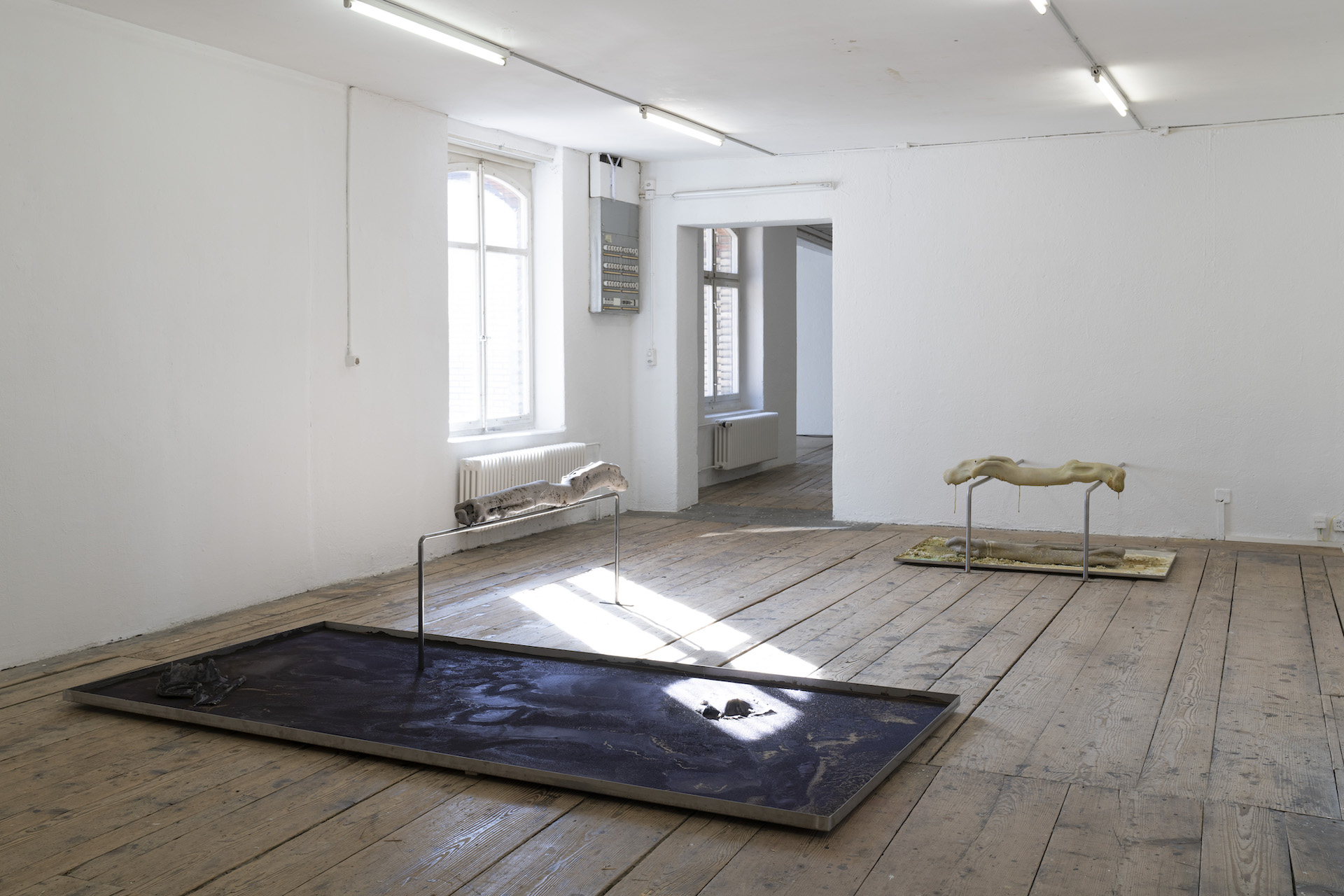Issue de secours
Isabelle Andriessen, Brigham Baker,
Isabell Bullerschen, Chloe Delarue,
Maya Hottarek, Val Minnig
20.5 - 19.6.2021










Images: Claude Barrault
Imagine we’re in an airplane, and we realise that our final destination doesn’t exist anymore, or has never existed. So we suddenly have no destination, but we also can’t turn back - there is not enough fuel. All that is left is an emergency landing. But where and how? This metaphor taken from Bruno Latour that Maya Hottarek pointed out in one of our conversations sums up our current predicament. Will this machine we have built for ourselves bring us to a safe landing? Hottarek’s spiralling “What
flies out of the window comes back in the door” speaks of action and reaction, karma, a certain balance, something her mother used to teach her. As we drift past all the worrying events of the past years and realise in the words of Bernard Stiegler, that “anthropocene discloses itself as a dead-end trap”, hopefully, we also learn something. And if there is anything our gathered knowledge should help over- come, it is the utter imbalance of the needs of the society and the structures it has created for its own survival.
Conceived as a conversation and an exchange, Issue de secours offers six artistic positions on the irre- versible condition of entropy. If we consider Robert Smithson’s definition of entropy “a closed system which eventually deteriorates and starts to break apart and there’s no way that you can really piece
it back together again”, than our attempt at survival on this planet can be defined as “entropic boot- legging” - a futile attempt to organise, to reconstruct something that has been broken into a chaos of tiny little pieces. All things tend towards disorder, it is after all the second law of thermodynamics. The degree of this disorder is essentially the definition of entropy - with the passing of time, the entropy (or the degree of disorder) of any isolated system will increase. Energy disperses and systems dissolve into chaos. This is an irreversible process present in nature and reinforced by human intervention.
In her work Ouroboros - an ancient trope for an endless circle - Isabell Bullerschen associates the concept of entropy with the disintegration of stone paper through exposure to sunlight. This curious material that serves as a second skin to blacklight neon serpent, is produced with limestone powder and is essentially the perfect recycled material, being a waste product from stone quarries. But the small percentage of polyethylene that is used in it as a binder and that gets released into the air as the stone-paper breaks down under the UV radiation dissipates this dream into pieces.
A different kind of contamination is at the heart of Isabelle Andriessen’s Tidal Spill, an installation comprised of several sculptural elements that ooze, oxidize and grow crystals, evolving through time. She investigates ways to physically animate inanimate (synthetic) materials in order to provide them with their own metabolism, behavior and agency. Her sculptures are active characters inhabiting the liminal space between sculpture and performance. They become persistent and contagious; they refuse to stay fixed and yet they expand. Like eerie performers, composed of materials that act and evolve, the works move seemingly beyond control, and often irreversibly. The distinction between living and non-living matter is made deliberately ambiguous, revealing scenes in which these un-living, non-dead entities might eventually become our ‘natural-ish’ companions, invading and colonizing our constructed and contaminating environments.
The effects of friction and contamination between different elements and materials infiltrates Chloè Delarue’s TAFAA - FERTILITY DEVICE (NUDGE FOR THE SCAPEGOAT) and takes us back to how our emotions and behaviors can be transformed under the influence of indirect suggestions. Our cognition, which has become a merchandize like any other infused with the attention economy, becomes yet another raw material to be traded and whose value increases exponentially, with repercussions on the rises and falls of the emotional stock exchange of which traders are no more than algorithms feeding from our interactions.
Every basic need of ours is being automated by machines. The constant search and need for auto- mation is also found in the food we eat, in the livestock that we bread and is here exemplified with Val Minnig’s Rubber Coat. At 8AM, 10AM, 12AM, 2PM, 4PM and 6PM the automated grate of the food dispensary and the meadow of Mrs Seiler opens up and the horses can eat. The mats are urine proof and not slippery. A 2x2 m wooden frame filled with straw and chipped wood serves as a natural toilet. Mrs Seiler is happy. She can sleep in every day. The animals are fed, happy and clean.
Will this machine we have built for ourselves bring us to a safe landing? How can we imagine the con- tinued alliance of human life and the planet? How do we take care of each other in a world of disequi- librium? How do we react in an emergency and does the emergency exit exist at all?
curated by Kristina Grigorjeva
Vernissage
Do, 20.05.21
18 -21Uhr
Open Studios Stiftung BINZ39
Sa, 12.06.21
15 - 18Uhr
Artist Talk Daniel V Keller/Lithic Alliance
So, 13.06.21
17Uhr